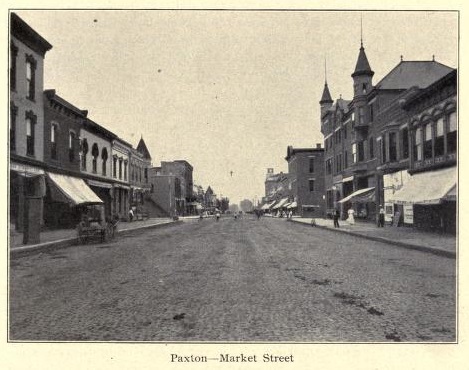HISTORY OF THE SWEDES
PAXTON, FORD COUNTY
Ford county was organized in 1859. Two years before there arrived the first Swedish settler, Sven Hedenskog, superintendent of a large country estate in Halland, Sweden, who emigrated in 1857, settling a few miles west of the site of Paxton. Being a poor man, he was obliged to undergo the severest hardships, but his fortitude stood the test and he had succeeded in accumulating considerable property before removing in the latter seventies to Nebraska, where he died not long after.
In 1859 a sailor by the name of Carl Andersson and one Anders Olsson, both from Helsingland, settled in the vicinity of Paxton. Andersson in the seventies removed to Colorado, leaving a daughter in Paxton. Olsson was still living on a farm three miles south of the city in 1880 and was then in comfortable circumstances. There was no great influx of Swedes to Paxton until 1863, when they began to settle here in considerable numbers, for reasons presented in the following.
In 1860, the year of its organization, the Augustana Synod established in Chicago the Augustana Theological Seminary for the purpose of preparing young men for the ministry. While the synod was still small, its members few and there was difficulty in raising the money needed for the support of the seminary by free contributions, some of the leading men conceived the idea of purchasing a large tract of land and by selling farms to prospective settlers procure the funds needed to secure the permanence of the institution. The directors of the seminary, who were authorized to look up a suitable tract, after visiting a couple of states for that purpose, without arriving at any conclusion, received from the Illinois Central Railway Company an offer of a suitable tract of land at Paxton. The offer was accepted and an agreement signed by both parties in February, 1863. This brought quite a number of settlers to the place, yet they did not come in such numbers as to insure the success of the plan, causing the authorities after a few years to cast about for a new location for the school. A more detailed account of these transaction will be found in the historical sketch of Augustana College and Theological Seminary.
Among the settlers was Erik Rasmusson from Gammalstorp, Blekinge province, who had emigrated ten years before, locating near Galesburg in 1853. Other contemporary settlers of Paxton were. Carl Larsson, Erik Carlsson, John Andersson and A. M. Hansson, who all bought farms and located there permanently. In 1864 J. H. Wistrand came to Paxton and was in business there until 1875, when he removed to Moline and opened a store in that city. Simultaneously with Wistrand came Petter Hedberg from Attica, Ind., who established a lumber yard. He became justice of the peace and later was elected tax collector. Ill health compelled him to remove to Denver, Colorado, in 1873, where we find him serving as Swedish-Norwegian vice consul in 1880.
From Attica, Ind., where Swedes had settled in the early fifties, a number of these removed to Paxton in 1865, among whom Fredrik Bjorklund, Carl Fager, John Svan, John Johnson, Carl Pettersson, Petter Larsson, Carl Johnson, Adolph Johnson and John Nelson, all farmers, except Larsson and Nelson, who were merchants.
The influx of Swedish settlers continued steadily until 1870, but not on so large a scale as the Synod and the directors of the institution had hoped. The removal of the institution to Rock Island in the seventies naturally worked to the detriment of the Paxton colony, many of the Swedish settlers leaving for other places farther west. During the next few years, however, the exodus was partly counterbalanced by an increased immigration from Sweden.
The Swedish element in Paxton has predominated in many respects from the first. This is especially true with respect to local politics and business pursuits. Around Paxton Swedish farmers are living in great numbers, most of them being in very comfortable circumstances. part. The Swedish Lutheran congregation there dates back to 1863. In 1878 a Swedish Mission church was organized, but the Methodists and Baptists have not seen fit to enter this field.
In 1900 the population of Paxton was 3,036, and in 1905 there were approximately 3,000 Swedish-Americans living in and around the city.
Extracted 28 Jan 2017 by Norma Hass from History of Swedes of Illinois, published in 1908, Volume 1, pages 346-348.




